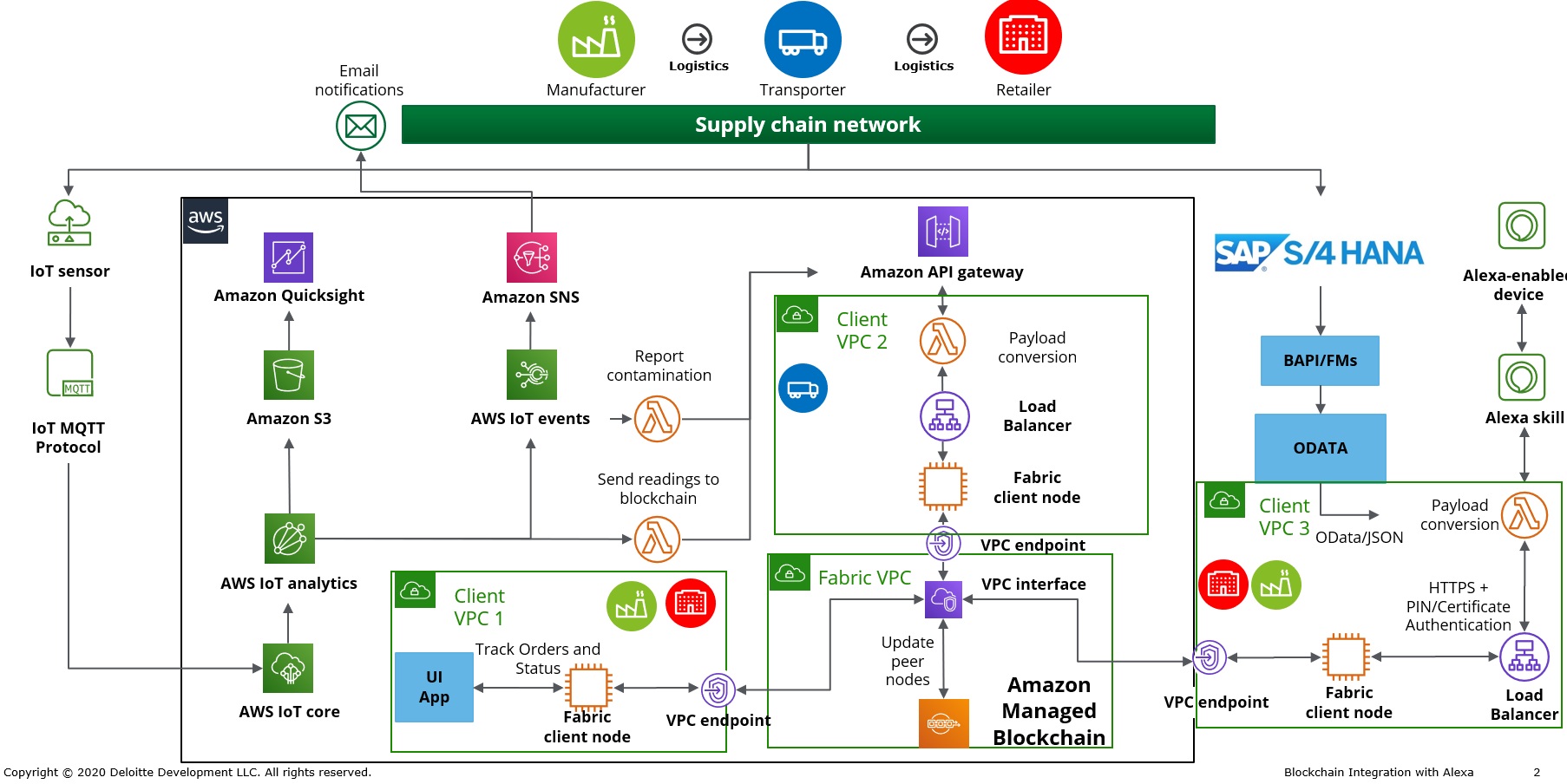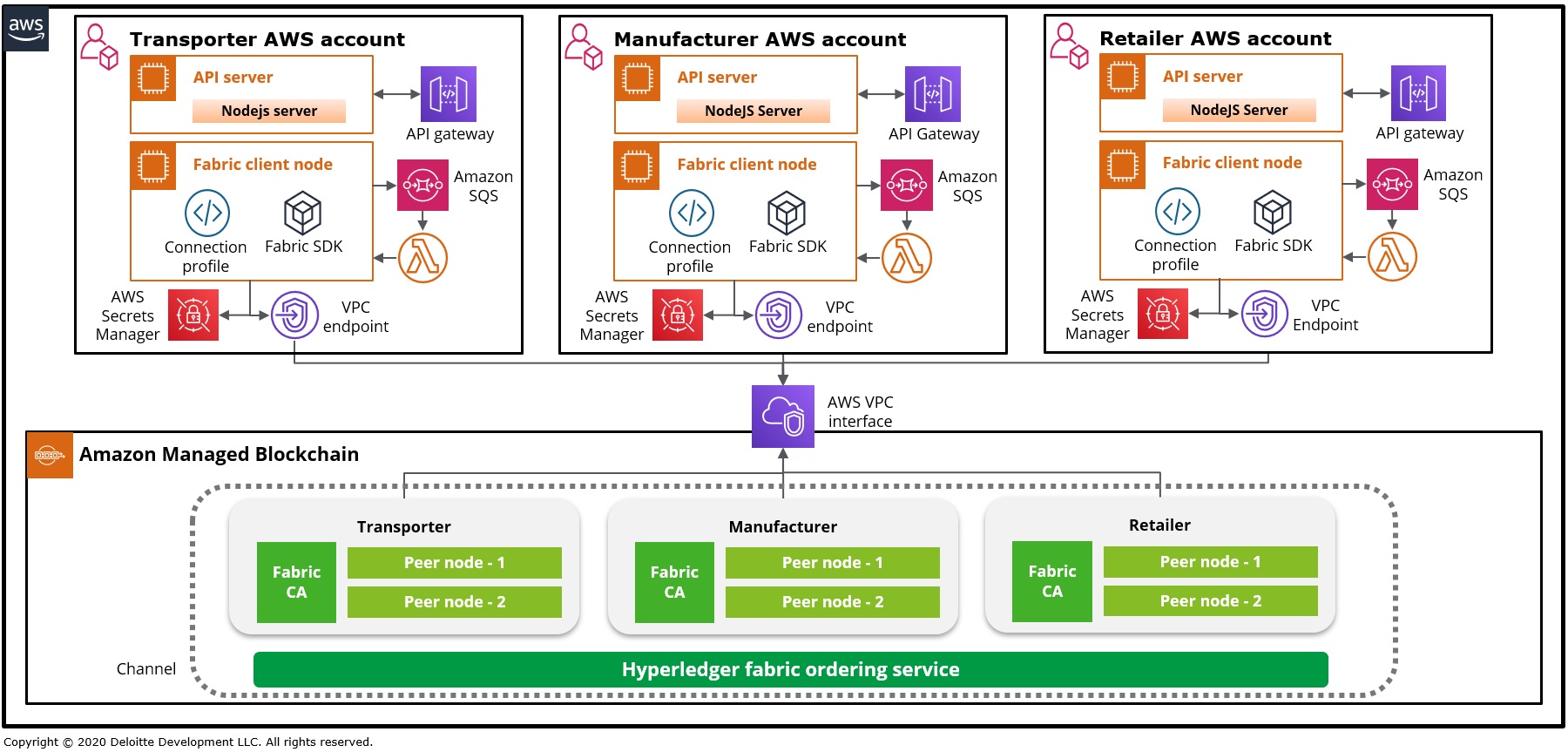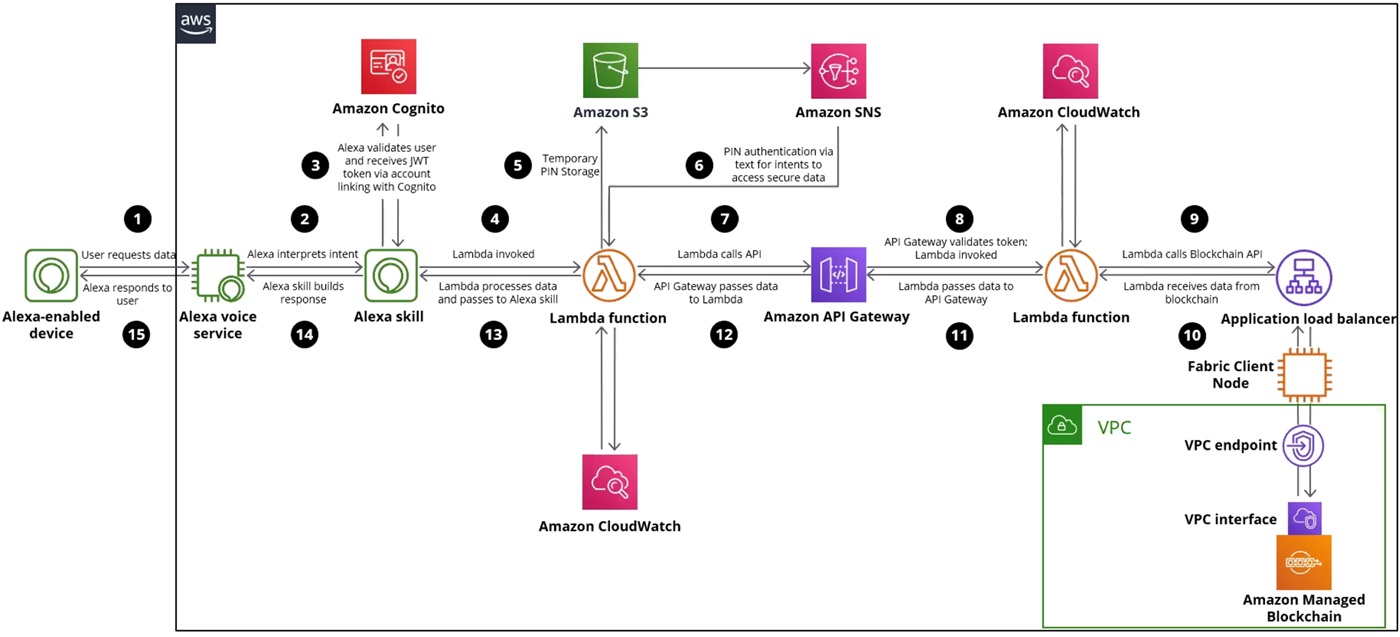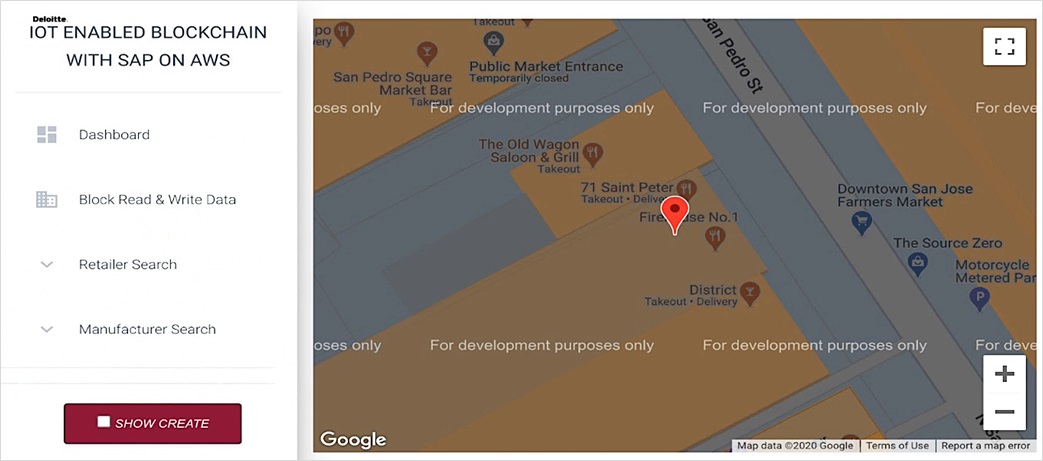AWS Partner Network (APN) Blog
Supply Chain Tracking and Traceability with IoT-Enabled Blockchain on AWS
By Balbir Wadhwa, Sr. Manager at Deloitte Consulting
By Kenny Rajan, Scott Francis, and Manas Srivastava, Sr. Partner Solution Architects at AWS
 |
 |
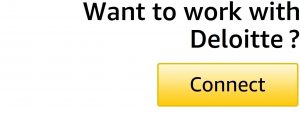 |
Many companies today are challenged to ensure the resiliency of their supply chain operations against the disruption of geopolitical events, climate-related disasters, public health crises, and more.
These companies are often making investments to withstand this disruption, across customer demand, supply of materials, and logistics services. Yet, outdated, rigid systems and strategies are causing investments to fail—as these systems cannot adequately provide an end-to-end view across the dependencies both inside and outside the enterprise.
Implementing truly resilient supply chain solutions calls for a fully functional, flexible technology platform along with services that enable traceability and transparency. This can empower parties in the supply chain to have all the right information available, and make decisions driven by real-time data generated from distributed supply networks.
One of the key considerations to building an effective supply chain network is deploying resilient, scalable technology that can break down technical and functional silos. Effective solutions increase visibility and help organizations connect with their complete network for end-to-end visibility, collaboration, agility, and optimization.
In this post, we’ll explore how Deloitte’s Internet of Things (IoT)-enabled blockchain solution for supply chain can help organizations create transparency and promote trust in their supply chain with a single source of truth for product quality and traceability.
Designed for rapid addition of supply chain products, channels, and members, Deloitte’s solution enables agility to adapt to emerging issues, provide real-time visibility of product events, and reduce business friction by streamlining contractual negotiations between participating parties in the supply chain.
The solution is powered by AWS IoT, Amazon API Gateway, AWS Lambda, and Amazon Managed Blockchain services, and further enhances the user experience by enabling transactions using Alexa; allowing users to securely and accurately track supply chain assets through voice commands.
Challenges
Challenges with product traceability and transparency in a supply chain network include:
- Inconsistencies: Siloed data sources handled by individual parties in the supply network creates a lack of transparency, and reconciling discrepancies can be time consuming and costly.
- Maintenance: Manual, paper-based processes can be misleading, inefficient, and difficult to maintain.
- Contamination: Identifying a source of contamination without consistent product traceability information can cause costly delays.
- Audits: Disparate sources of data without a single source of truth can lead to difficult, time consuming audits.
- Quality: Without real-time tracking capabilities, organizations risk product quality and the agility to respond to issues in a timely manner.
How Blockchain Enables Traceability and Transparency
A blockchain is a tamper-evident, verifiable single source of truth that is shared across all participating organizations. Each participant holds an identical copy of the data in a decentralized ledger.
Writing data to a blockchain creates an immutable record where no single entity owns or controls it. This enhances traditional double-entry bookkeeping and helps reduce potential for human errors like accidental deletions, due to blockchain’s inherent immutability.
There are many industry scenarios where a blockchain solution may be useful to provide supply chain traceability and transparency:
- Retail and consumer packaged goods (CPG) businesses: Many retail and CPG organizations want the ability to connect their suppliers with a common ledger that reduces leakage from shipping to shelf, and ensures complete and accurate historical records in the event of a recall.
. - Banking, capital and trading markets: Banks and export houses can create consortiums to perform cross-boundary transfers of financial assets (letter-of-credit, for example) amongst each other, without a costly centralized authority acting as a liaison.
. - Manufacturing and distribution with provenance: Blockchain solutions can be layered on top of existing plant data histories to improve data security and transparency. The “provenance” of a goods refers to its origin, as well as a chronological record of its ownership, location, and other important information as it moves along a supply and distribution network. With blockchain, data can be stored from multiple systems into a shared ledger to accurately track the production and distribution lineage of products.
. - Automotive: A shared blockchain system enables immutable and real-time data to be securely shared across automotive parties within complex inbound and outbound supply chains. This improves coordination between automotive suppliers, transporters, and retailers to accurately track metrics such as automotive part status and location in real-time.
Storing Information in a Tamper-Proof, Distributed, Consensus-Based Ledger
For perishable, priority, or high-value goods that may require detailed and accurate tracking, a demonstrated method is to store information in a tamper-proof, distributed, consensus-based ledger. Many organizations build applications with ledger-like functionality because they want to maintain an accurate history of their applications’ data.
There are multiple approaches for creating these ledgers. Blockchain frameworks (such as Amazon Managed Blockchain with Hyperledger Fabric) require that to execute a transaction, the majority of members of the network must reach consensus on the validity of the transaction. On the other hand, Amazon Quantum Ledger Database (QLDB) has a centralized design, allowing its transactions to execute without the need for the multi-party consensus.
Deloitte’s solution leverages the Hyperledger framework, as it supports the decentralized trust and consensus mechanisms that provide value to supply chain networks with several distinct participating organizations. An untrustworthy participant alone will not be able to change the state of the system due to the decentralized nature of the consensus.
Amazon Managed Blockchain with Hyperledger Fabric
Building a scalable blockchain network with existing technologies can be complex to set up and hard to manage. To do so, each network member needs to manually provision hardware, install software, create and manage certificates for access control, configure networking components, and continuously monitor the infrastructure to support the resource requirements.
To help ease the burden of running a blockchain network, Amazon Web Services (AWS) created Amazon Managed Blockchain, which is a fully managed service that makes it easy to create and manage scalable blockchain networks using popular open source frameworks such as Hyperledger Fabric.
Amazon Managed Blockchain helps eliminate the overhead required to create the network, and automatically scales to meet the demands of thousands of applications running millions of transactions. Once the blockchain network is up and running, Managed Blockchain makes it easy to manage and maintain. It manages certificates and enables easy provisioning of new members on the network.
This decentralization of network management helps the supply chain to adapt quickly and dynamically to new providers, without relying on centralized approval that could be time-consuming.
Figure 1 – Architecture of the Amazon Managed Blockchain network with user interface integration.
Real-Time Tracking of Goods in the Supply Chain Using IoT
Across industries, organizations are looking for solutions that feature product tracking during transit to ensure deliveries are compliant with organizational standards. Knowing the state of priority goods is crucial for many industries that rely on strict quality control and accurate product tracking, such as manufacturing, consumer packaged goods, and retail.
The ability to accurately track and manage product status data can enable real-time data insights, faster issue identification and resolution, and ultimately improved decision making and operational efficiencies. Tracking solutions can leverage various IoT devices to provide real-time product data at selected stages of the supply chain, and integrated solutions can securely pull from that data stream to automatically notify relevant participants of any potential risks.
A secure, reliable, enterprise-grade solution that can ingest and store massive amounts of IoT data, combine it with data from other parts of the business, and then analyze and apply sophisticated data science to set up alerts and deliver key insights is what businesses demand today.
Tracking Goods-in-Transit with Deloitte’s IoT-Enabled Blockchain
Developing and integrating IoT devices with supply chain solutions capable of tracking assets at scale is complex. IoT data can be highly unstructured, which makes it difficult to analyze with traditional analytics and business intelligence tools.
IoT data often comes from devices that record noisy processes, such as temperature, motion, or sound. This can frequently lead to significant data gaps, corrupted messages, and false readings that must be cleaned up before accurate analysis can be achieved.
AWS IoT Analytics automates each of the unique steps required to effectively analyze data from IoT devices. The service can collect and filter device data, apply mathematical transformation for processing, and enrich the data with device-specific metadata, such as device type and location, before storing it in a time-series data store for analysis.
Deloitte’s IoT-enabled blockchain solution uses AWS IoT Core to securely ingest sensor data into the blockchain over low-bandwidth network connections using protocols such as MQTT and AMQP. AWS IoT Core then scales as needed to accommodate additional devices and data without the need to create standing infrastructure.
Sensor devices are designed to receive current coordinates of the delivery truck to the AWS IoT Core every five seconds. These measurements can often be noisy, have errors, or simply be missing. AWS IoT Analytics is used to filter these telemetry streams and enrich the data messages to facilitate downstream processing and store the filtered data in an Amazon Simple Storage Service (Amazon S3) bucket every minute.
With AWS IoT-enabled tracking, organizations can determine whether the products are shipped within defined temperatures (max/min)—in near-real time—and mark the material handling unit as contaminated if the temperature of the shipment containers does not meet the defined criteria. Once the cleaned readings are ingested into the blockchain, tracking functionality and status updates are immediately available to network member organizations.
Weaving More Value into Existing SAP Solutions
Deloitte’s IoT-enabled blockchain solution features integration capability with SAP solutions, which are used for a wide variety of supply chain use cases.
To maintain a single source of truth, SAP data such as certificates, invoices, purchase orders, and sales orders can be streamed directly into the solution’s blockchain ledger using SAP ODATA and HTTPS layer. This fosters consistency and transparency between important sources of information by having cleaned IoT data and SAP data both feeding into a secure, shared blockchain.
A hybrid solution that integrates SAP supply chain processes and IoT with a blockchain network creates numerous unique opportunities and advantages. The security, real-time monitoring, and transparency offered by the solution can combine with the familiarity of existing SAP systems to create an intuitive system that leverages securely-stored data to drive immediate insights.
Figure 2 shows a blockchain networking including three supply chain participants.
Figure 2 – Architecture of Deloitte’s IoT-enabled blockchain solution with SAP integration.
Simplifying Supply Chain Tracking with Voice-Enabled Applications
Deloitte’s supply chain technology also offers voice-based interaction features to provide rich, personalized voice experiences redefining how users engage with their supply chains.
Using Alexa-based technology with supply chains enables a hands-free experience for employees and members within the blockchain network to access important information like inventory levels, quality issues, and transportation status.
Figure 3 – Alexa integration with Deloitte’s IoT-enabled blockchain solution.
This offering includes layered security features like authentication with Amazon Cognito and PIN authentication using Amazon Simple Notification Service (SNS) and Amazon S3. This ensures blockchain transactions are only performed by those who hold valid credentials as part of a member organization inside the blockchain network.
Avoiding Ambiguity with Detailed Visual Representation
A good reporting system should have complete, credible, and reliable data flowing from approved sources to the verified users.
Deloitte’s IoT-enabled blockchain solution incorporates a user interface (UI) which fetches the data from the blockchain to depict the lifecycle of a transaction with detailed visual representations of key supply chain data coming from SAP systems.
Users within the supply chain network can view the purchase orders, sales orders, production orders, deliveries, good receipt related transactions, material batch information, and changes of ownership within the supply chain can be viewed on a permissioned basis.
Figure 4 – Custom-built user interface reporting for Amazon Managed Blockchain.
Shipment and Batch Visibility with IoT-Enabled Blockchain
Amazon Managed Blockchain stores shipment details sent from connected systems, providing visibility to the supply chain lifecycle. This is enabled by real-time querying of shipment location status in the blockchain to allow parties in the supply network to make timely decisions that optimize idle transit times.
Reported GPS data from IoT devices associated with a shipment are streamed in real-time into the blockchain; the solution’s UI correspondingly updates to show detailed location information on a map for a given shipment, as shown in Figure 5 below.
Tracking in this way maximizes transparency across all the supply chain participants involved in the solution.
Figure 5 – Custom-built user interface reporting to provide real-time shipment location using AWS IoT.
Summary
Lack of transaction and inventory visibility continues to be a significant challenge for many enterprises. Traceability and transparency are crucial, especially for a successful supply chain flow to make immediate decisions.
When organizations take advantage of the opportunity to modernize their supply chain operations, they can recognize the transformational advantages of scalable, reliable, and automated cloud infrastructure-based technology to create innovative solutions.
IoT-enabled Blockchain solutions powered by AWS can provide the traceability needed to track product quality, store SAP supply chain events data with a tamper-proof solution, sustain product lifecycle information as a single point of truth inside a distributed ledger, and create an efficient communication mechanism to share information between supply chain members.
Deloitte is an AWS Premier Consulting Partner with AWS Competencies in IoT, SAP, Big Data, Financial Services, and more. Deloitte is also a member of the AWS Public Sector and AWS Managed Service Provider Partner Programs.
.

.
Deloitte – AWS Partner Spotlight
Deloitte is an AWS Premier Consulting Partner and MSP. Through a network of professionals, industry specialists, and an ecosystem of alliances, they assist clients in turning complex business issues into opportunities for growth, helping organizations transform in the digital era
Contact Deloitte | Practice Overview
*Already worked with Deloitte? Rate the Partner
*To review an AWS Partner, you must be an AWS customer that has worked with them directly on a project.
